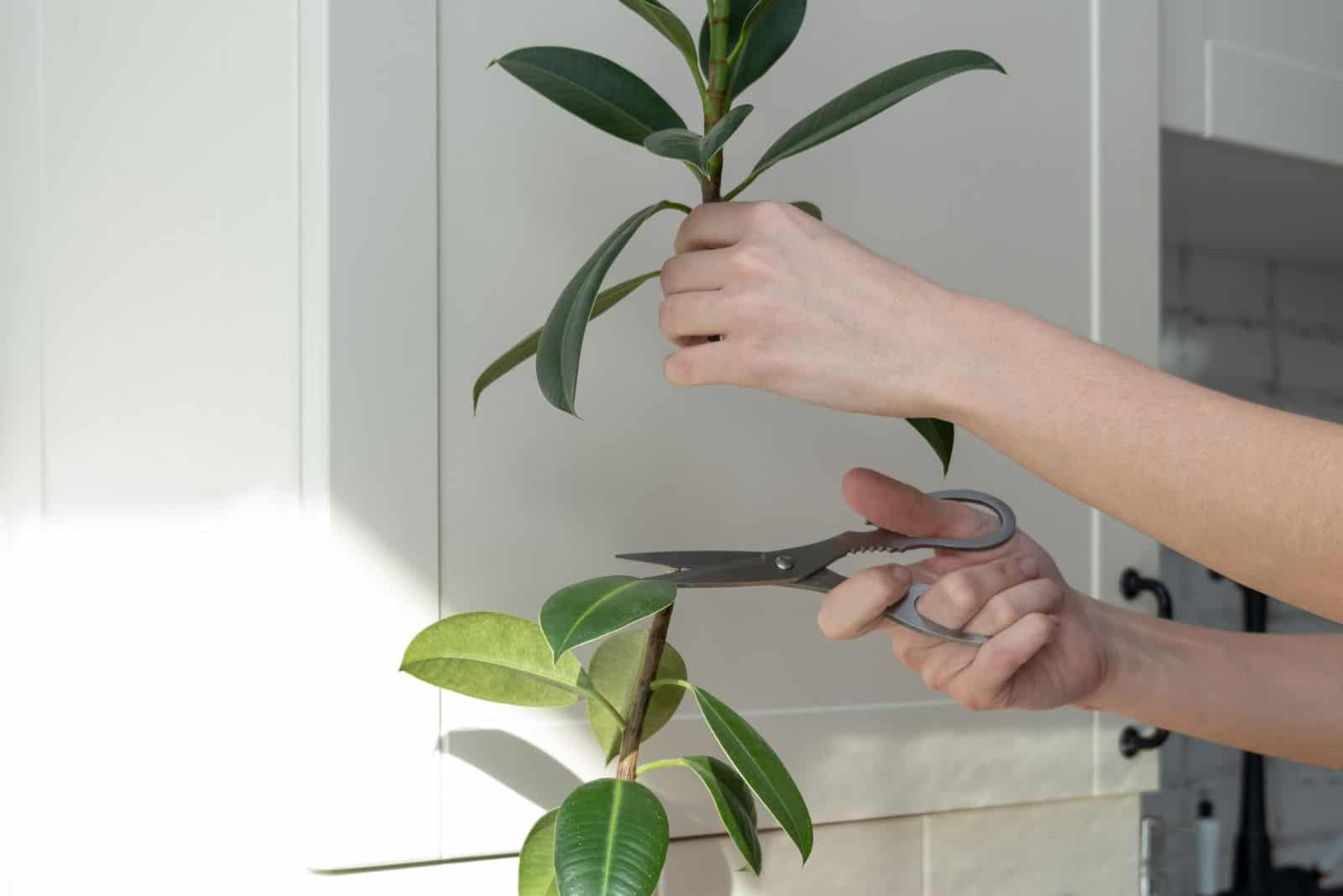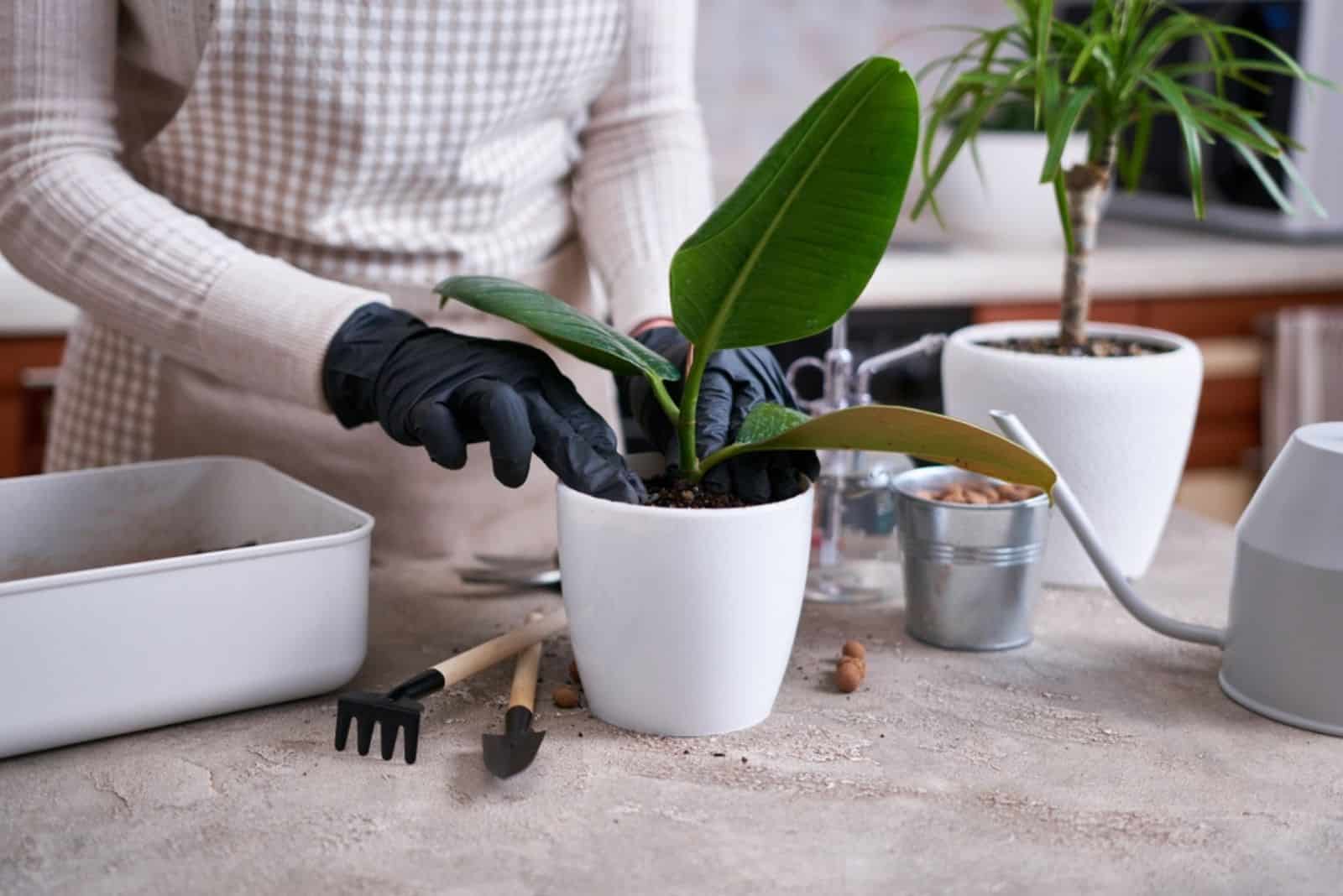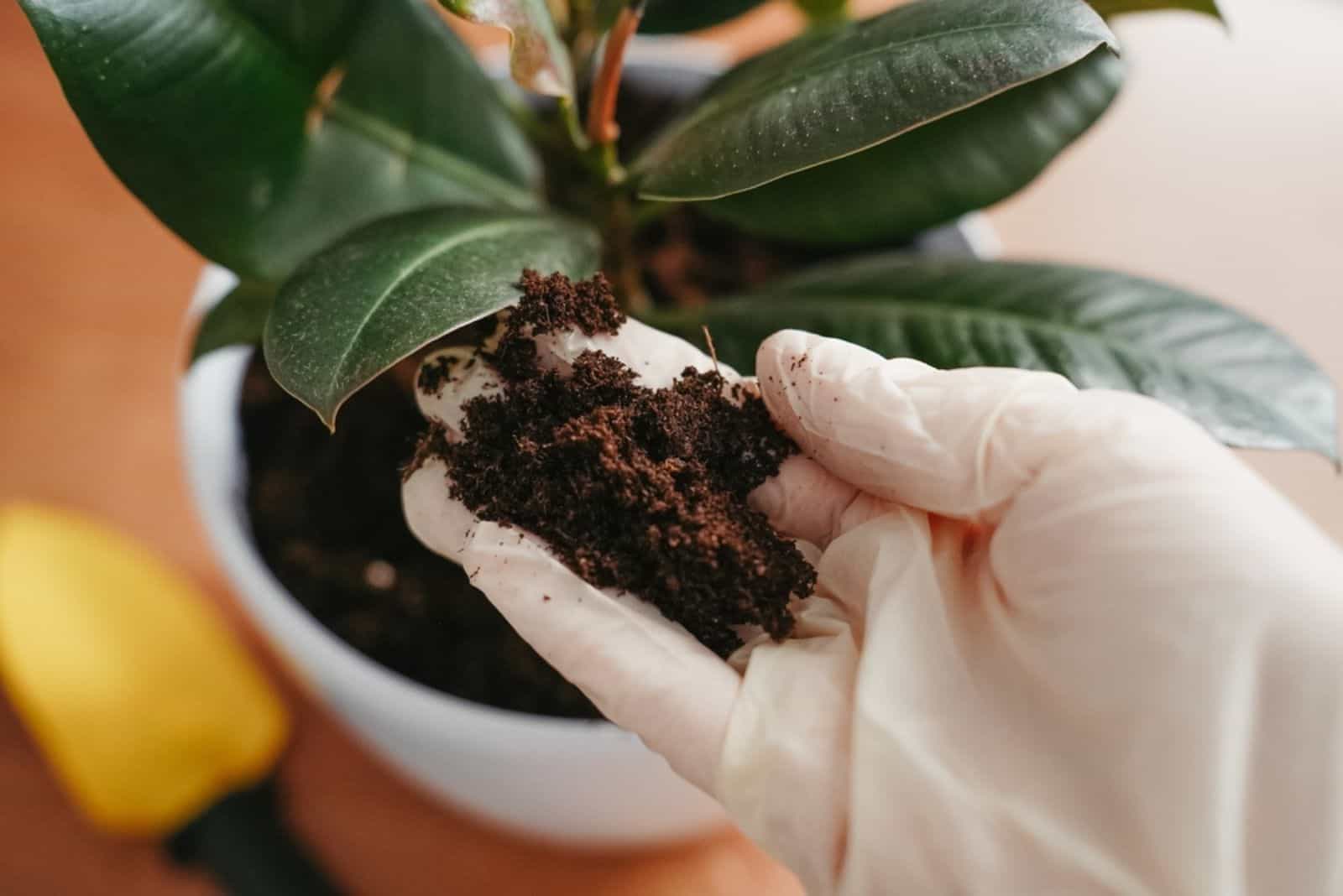The rubber plant is one of the most popular houseplants around the globe due to its undemanding care guide and stunning looks. However, it isn’t surprising for it to turn spindly and leggy due to lack of sunlight, a small pot, or irregular pruning.
In this article, we’ll bring four amazing pruning tips so that you can learn How to make a rubber plant bushy.
We’ll also include some additional advice to make trimming this plant an enjoyable chore.
And once you finish, you can always propagate the stems to create new plants that you can give to your loved ones or plant alongside your ficus to develop a semblance of bushiness.
Of course, adequate plant care is also essential, which is why we’ll bring you some quick growing tips that will keep this indoor plant thriving.
Before we examine all that, let’s find out more about the rubber plant:
[table id=581 /]
How To Make A Rubber Plant Bushy
The Ficus elastica belongs to the list of stunning purple houseplants, but a spindly and leggy rubber plant is definitely not attractive.
Luckily, you can easily make it bushier by implementing regular pruning into your routine. And after you remove some stems, you don’t have to throw them away; you can simply propagate them and place the new growth all over your reading or living room.
1. Pruning A Rubber Tree Plant
Pruning rubber plants is one of the best ways to promote new branches and fill empty spaces. But how exactly should you do it?
First, make a plan on what you want to remove, prepare the plant to prevent the sticky sap from dripping everywhere, and then get to pruning; starting with the damaged leaves.
You should also know that it is safe to prune younger plants, and that’s actually when you should start trimming it if you want a bushy and tall tree.
1. Preparing The Houseplant
Preparing the rubber plant for pruning refers to identifying dead, damaged, or diseased foliage, stems, and branches that you need to remove.
Plan to which height you want to shorten it, which shape you want to give it, and so on. For instance, if you have a small place for this plant, you should prune it to a more compact form so that it can fit.
You should also lay some paper, towels, or plastic underneath the flower because the milky white sap can stain the floor and/or carpet.
2. Removing Damaged Foliage
Once you’ve made a plan, it is time to get pruning! First, remove the drooping foliage and any leaves that are horizontal and not upright.
Then, continue removing old, pale, and diseased parts that take up space for new growth and waste your plant’s energy.
After you finish with that, you can remove any broken and damaged branches.
It is important to note that you should always remove the foliage above the nodes so the new leaves can grow.
3. Remove The Top
One of the best pruning tips we’ve ever gotten was to remove the top of the main stem to make it bushier.
This technique will encourage spreading, and two new stem branches will fill in for the old top.
4. Cutting To The Desired Height
It is okay to prune up to 1/3 of the entire plant, so don’t be afraid to cut more than just a leaf or two.
Decide what your desired height for the rubber tree is, and trim it down to it. Just remember to always prune above the leaf node to save your plant from infections and death.
Finally, you can prune it frequently throughout its growing season, but stick to the 1/3 rule.
5. Shaping The Rubber Tree
Once you remove all the damaged parts and shorten your plant to the desired height, it is time to shape it.
Remove leggy rubber plant growth because it is too heavy and the main stem cannot support it, so it will droop eventually.
And if you want to prevent legginess, simply give your plant enough light (preferably indirect light), and you won’t have to deal with this issue.
2. Repotting The Ficus Elastica
The Rubber tree doesn’t mind being rootbound for a while, but you should still repot it every 2-3 years. If you leave it in the same container for too long, it won’t put on any new growth.
The best time to repot it is in late spring, when you can be sure it’s actively growing.
Find a larger pot, fill it with well-draining potting mix, place the ficus in it, and cover the roots with more soil.
Water the plant thoroughly and place it away from direct sunlight to reduce transplant shock (and to bring a companion to your pothos or spider plant).
3. Providing Proper Plant Care
You need to provide proper care to your rubber plant if you want to see new growth. And when it comes to care requirements, you have to pay attention to the lighting, watering, soil, fertilizer, and temperature.
Light: Ficus elastica plants thrive in indirect light, but can also handle low-light conditions to a certain degree. Avoid placing them in direct sunlight, which can cause the foliage to turn yellow or burn. Additionally, the leaves of your ficus may curl if exposed to direct sun.
Watering: Water your rubber plant when the top 1-2 inches of the growing medium are dry. Avoid letting the soil dry out completely, as this can cause the plant to wilt. Overwatering can also be a problem, so drain any excess water from the pot to prevent root rot.
Soil: Use a well-draining potting mix specifically formulated for houseplants. Rubber trees prefer a mildly acidic soil pH of 6.0-6.5.
Fertilizer: The Ficus elastica benefits from regular fertilization during the growing season. Use a balanced liquid fertilizer at half strength every 2-4 weeks.
Temperature: The Ficus elastica thrives at room temperatures between 60-75°F. Avoid placing them in areas with extreme temperature fluctuations or drafts.
4. Staking The Rubber Tree Plant
The Ficus elastica is a tall tree and benefits from staking, which helps support its weight and makes it easier to put on new growth and stand tall.
When you find an appropriate trellis (a bamboo stick or a metal one), stick it into the ground and ensure it is firm enough.
Tie the plant to the stake using soft, flexible ties or strips of cloth. Avoid using wire or other materials that could damage the stem or leaves of the plant.
As the plant grows, adjust the ties and move them higher up the stake to support the plant. Don’t fasten the ties too tightly, or they will damage the plant.
5. Rubber Tree Propagation
Propagating the rubber plant might not seem like it would make much difference, but when the new plant grows a bit, you can plant it with your ficus, especially if it has sparse lower leaves.
There are many different methods of plant propagation, but if you don’t want to waste stems from pruning, you can multiply them.
Simply dip them in some rooting hormone, and plant them in a nursing tray filled with seed starting mix. Maintain consistent soil moisture and put a humidity dome or a plastic bag over the cutting.
* You can propagate the rubber tree plant in water; just remove the lower leaves from the stem to prevent rotting and contamination of the medium.
Expose the stem to indirect light and keep it at room temperature for optimal growth.
Here are some more tips that can help you multiply your Ficus elastica successfully:
Rubber Plant Pruning Tips
We analyzed some useful tips and tricks for making your rubber plant branch, but there are still some things we need to mention that can improve your overall experience, such as when to prune, which tools to use, etc.
When To Prune Rubber Plants
The best time to cut your rubber plant is in late spring or early summer because that’s when it grows.
Of course, you can do it earlier or later in the season, but remember that it needs light and warmth to produce new leaves and branches.
Wearing Gloves
It is important to wear gloves when pruning and repotting the Ficus elastica because it contains white sap, which can cause skin irritations and gastrointestinal issues if touched or ingested.
Using Sterilized And Sharp Tools
It is essential to use sharp and clean shears when pruning a ficus (or any other plant) so that you don’t tear the branches or transfer bacteria and fungi.
You can also get pruners for arthritic hands if you need to do some heavy cutting, as they have ergonomic handles and require less pressure to get the job done.
Avoid Pruning Newly Repotted Plants
If you have just repotted your Ficus elastica, or are planning to do so, don’t prune it just yet.
Both actions stress your plant, and if you do them at the same time, it will be quite challenging for it to recover.
Removing Damaged Parts
Remember to cut damaged and diseased stems and branches as soon as you see them to stop the infection from spreading.
This technique also makes room for new branches and leaves, and keeps your plant fresh and pretty.
Don’t Overprune
It is essential to cut only 1/3 of the entire plant, whether you follow the care guide for a variegated rubber plant or any other species.
If you prune more than this, you will stress your plant and it will photosynthesize at a slow rate (because it won’t have enough foliage) and grow slower.
How To Stop Rubber Plant Sap Dripping
The best way to stop rubber plant sap from dripping is to cover the wound with some compost.
It will heal in a couple of days and leave no stains or cause skin irritations.
Final Thoughts
If you’ve been wondering how to make a rubber plant bushy, you can simply start pruning it and enjoy its lush appearance.
Of course, you need to first remove damaged and diseased parts, shorten the plant, and finally shape it.
You should also repot it and implement proper care, or your plant won’t produce new branches and foliage.
Propagating plants can help you create a bushier appearance; simply plant the newly propagated ficus with your old one into a large container!
We also included some pruning tips, such as when to do it, which tools to use, how to stop rubber plant sap from dripping, etc.
Good luck, and enjoy your bushy ficus!
Like this post? Share or pin it for later!





